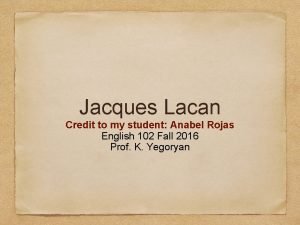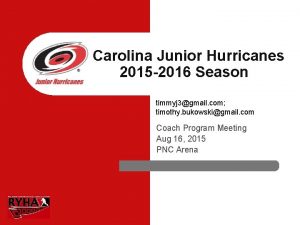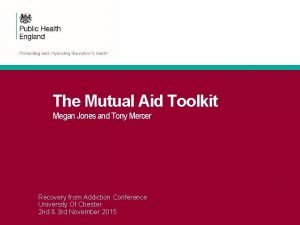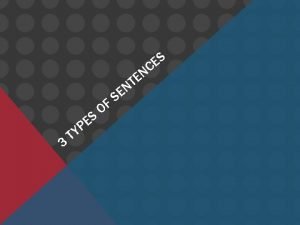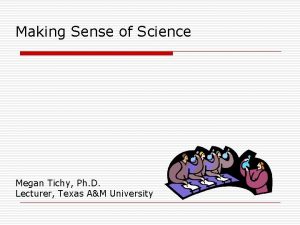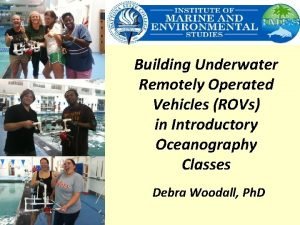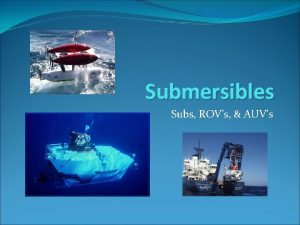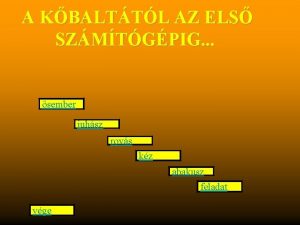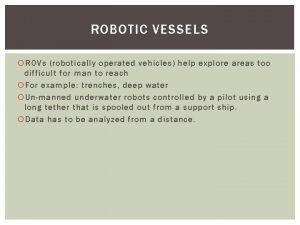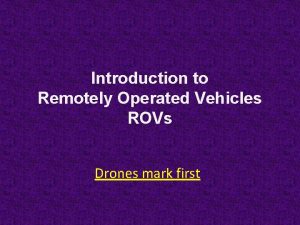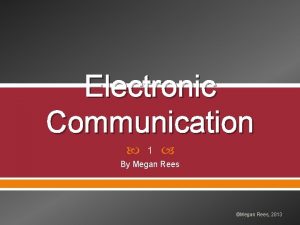Intro to ROVs Megan Mc Donald EARTH 2018














- Slides: 14

Intro to ROVs Megan Mc. Donald EARTH 2018

Summary This is an introductory lesson to familiarize students with how ROVs are built and why ROVs are used. Students will observe a variety of deep sea organisms using MBARI You. Tube videos and the MBARI Deep Sea guide. Students will explore the subject of why and how ROVs are used to collect data regarding the deep sea. Students will work to design a model ROV that will be used in a later lesson to build a functioning ROV.

Key Concepts ● ROVs are used to explore places humans cannot go ● ROVs must have neutral buoyancy ● There is a diverse population of organisms in the deep sea

Objectives ● Design a model ROV using a variety of materials ● Develop a simple sketch, drawing, or physical model to illustrate how the shape of an object helps it function as needed to solve a given problem (NGSS K-2 -ETS 1 -2) ● Ocean Literacy Principle 5. E. The ocean provides a vast living space with diverse and unique ecosystems from the surface through the water column and down to, and below, the seafloor. Most of the living space on Earth is in the ocean. ● Ocean Literacy Principle 7. D. New technologies, sensors, and tools are expanding our ability to explore the ocean. Scientists are relying more and more on satellites, drifters, buoys, subsea observatories, and unmanned submersibles.

Materials ● ● ● ● Pipe cleaners Coloring Sheet K’NEX Clay Tape Rulers Handout with pictures of ROVs ○ https: //docs. google. com/document/d/1 ZKOJU 3 L 24 Q 49 lih. HCc. Jc. S 53 t 4 ZI 6 n 0 b. YN_nnex. Tp 78/edit? usp=sharing Video Links Worksheet PVC Pipe Paper Pencils Computers or i. Pads Index Cards Student worksheet (optional) https: //docs. google. com/document/d/1 ac 9 c. G 2 MXBMKma. GN 2 zk 5 g 1 Tp 6 CZ 23 YKsgl. L 79 uuza. Hjg/edit

Lesson Note Students should have a basic understanding of buoyancy prior to this lesson. This lesson may be broken up into multiple lessons, depending on how much class time you have.

Opening: Part I Students will watch videos of deep sea creatures from MBARI’s You. Tube channel and explore MBARI’s Deep Sea Guide. MBARI You. Tube Channel: https: //www. youtube. com/user/MBARIvideo/featured (Suggested: Squid Graveyard, Lost at Sea) MBARI Deep Sea Guide: http: //dsg. mbari. org/dsg/imagesearch National Geographic Deep Sea Creatures: https: //www. nationalgeographic. com/environment/oceans/photos/deep-sea-creatures/ Ask: How did we get this footage? What do you notice about the organisms in the video? Students will draw at least two deep sea organisms they observed in the videos on the ROV coloring sheet. https: //drive. google. com/file/d/1 OLh. IQa. N_9 A 7 Of 9 i. Qo. Cy 7 But 5 IYKHg. BZL/view? usp=sharing

Opening: Part II Students will watch videos of ROVs in action underwater: Introduction to ROVs: https: //www. youtube. com/watch? v=DK 1 np. QWTWn. Y Deep Ocean Video: https: //www. youtube. com/watch? v=p 0 G 68 ORc 8 u. Q Nautilus Website: https: //www. nautiluslive. org/ NOAA ROV Video: https: //oceanservice. noaa. gov/caribbean-mapping/rovvideo. html Discuss: Why do we use ROVs? Any predictions or background knowledge of how they work?

Teaching: Part I ● Have students work in pairs to build digital ROV on http: //pbskids. org/scigirls/games/aqua-bot-html 5 ● View slideshow of Stevenson ROVs ○ https: //photos. app. goo. gl/45 RHz. H 1 n. JFRc. G 4 yz 5 ● Share out what they notice about the materials and the size/shape of the ROV and how they affect the buoyancy

Teaching: Part II ● Have students complete this worksheet. ○ Allow time to draw blueprint model of ROV they want to build ○ Have laminated photos of various ROVs on tables for ideas (see handout) ● Provide materials for students to make a 3 D model of their ROV ○ May need to make several models from different angles (front, side, back, top) ○ See extensions and adaptations for different grade level ideas ● Do a gallery walk to allow students to see what others made and get ideas for how to modify their own.

Closing Ask students to reflect: ● What worked well in planning and building your model? ● How did you and your partner work together? ● How would you modify your model based on what you’ve seen your peers do? ● Why do we use ROVs? ● What types of organisms live in the deep sea? Do you have a favorite?

Assessment ● Formative assessments o Observe students working in groups and individually o Check for understanding using thumbs up, middle or down o Check student worksheet and coloring sheet o Exit slip/reflection: “What is one new thing you learned? ” “What is something you are wondering? ”

Additional Resources ● Example of a student drawing and pipe cleaner model

Extensions ● Use pipe cleaners with younger students and PVC pipe for older students ● Allow older students to independently explore MBARI Deep Sea Guide for images that interest them (to research for an extension using the data from VARS) ● Have younger students work with older students to turn their pipe cleaner models into actual ROVs ● Use K’NEX to build models for students who may need something more concrete than pipe cleaners ● Presentation (in person or video conference) by MBARI staff to share MBARI ROV and videos

